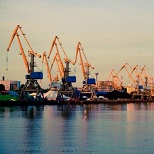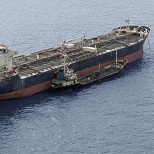Ukraine strives to control transshipment in Kerch Strait
The narrow Kerch Strait, which ranges from 4.5 to 15 kilometres wide and connects the Black Sea and the Azov Sea, is known as a convenient place for offshore ship-to-ship transshipment. Every year more than 15 million tons of cargo – predominantly oil, grains and fertilisers – are processed through the anchorage areas in the strait. More than 95% of this volume comprises Russian-origin commodities shipped from ports on the Volga and Don Rivers and the Caspian Basin by coaster ships, which is then transshipped onto large ocean-going vessels.
Transshipment in the Kerch Strait has faced a number of natural, political and legal issues over the years. The relatively shallow waters of the strait do not allow for safe passage of Panamax and Capesize vessels when fully laden. Moreover, a tangle of legal conflicts and loopholes has turned the strait into a 'grey zone', with the biggest problem being the strait's lack of clear legal status.
In accordance with Article 15 of the United Nations Convention on the Law of the Sea 1982, where the coasts of two states are opposite or adjacent to one another, neither state is entitled (failing agreement between them to the contrary) to extend its territorial sea beyond the median line, every point of which is equidistant from the nearest points on the baselines from which the breadth of both states' territorial seas are measured. This provision does not apply where it is necessary, by reason of historic title or other special circumstances, to delimit the territorial seas of the two states in a way that is at odds with the convention.
The Kerch Strait is a special case, as it is impossible to delimit the territorial waters at the median line. Therefore, the status of the strait has been determined by special agreements between Ukraine and Russia. The Treaty between Ukraine and the Russian Federation on Cooperation in the Use of the Azov Sea and Kerch Strait stipulates that the ??Azov Sea and the Kerch Strait have historically been the internal waters of both Ukraine and Russia, and that the settlement of all issues related to the Kerch Strait is to be carried out by agreement between the two countries. The border between Ukraine and Russia has not yet been officially demarcated.
In practice, this means that neither Ukraine nor Russia has full jurisdiction and control over the strait. This lacuna has led to the development of ship-to-ship transshipment and bunkering on anchorage places in the strait. Some of these anchorage areas are located within the Ukrainian zone of responsibility, while others are in zones controlled by Russia.
Although Ukrainian authorities have control over anchorages in respect of vessel traffic and navigational safety, they do not have territorial jurisdiction over the areas defined as 'transit anchorage places'. Anchorage areas are not included in the water areas of Ukrainian ports, so no state control procedures govern them. These anchorage areas are not a part of Ukrainian customs or state territory. Thus, technically all operations are arranged outside Ukrainian borders.
The obvious advantage for shipowners and cargo shippers is that transshipment and bunkering operations are undertaken under a 'transit' regime, thus avoiding customs clearance, border control and other types of government surveillance. This also allows for bunkering and transshipment without formally calling the vessels at port – therefore avoiding both payment of port charges and the need to obtain free practice for vessels.
However, the Ukrainian authorities have recently attempted to take control over transshipment on transit anchorages. In June 2013 the Cabinet of Ministers passed a decree that the anchorage areas within the Ukrainian zone of responsibility be included in the official water area of the port of Kerch. In view of international law and the bilateral treaties between Ukraine and Russia, the validity of this decree may be dubious.
Following the decree, the State Customs Service required that thorough customs control be exerted over all transshipment operations undertaken by vessels in anchorage areas. The customs authorities insist that the anchorage areas in the Kerch Strait fall within Ukrainian customs territory. However, considering the legal status of the strait as the 'internal waters of Ukraine and Russia', and in the absence of demarcated borders in the strait, this requirement is questionable in terms of territorial jurisdiction. Despite the fact that there are neither legal grounds nor effective fulfilment mechanisms for this requirement, the authorities are likely to continue attempts to expand their jurisdiction over the anchorages. In practice, this implies the abolition of the existing transit regime and the loss of all incentives for ship-to-ship transshipment in Ukrainian anchorage areas.
The Ukrainian Sea Ports Authority recently initiated a series of lawsuits against shipping agents in an attempt to recover unpaid port charges for the vessels which operated in anchorage transshipment zones after the decree of the Cabinet of Ministers came into force. The reasoning given was that all anchorages fall within the remit of port waters, and are thus subject to port charges. Court decisions on these matters will be crucial in determining the future of anchorage transshipment in the strait.
Notably, Russia has not yet given an official response to the matter. As it is a party to the bilateral treaties and a powerful player in the region, its stance on the issue may influence the position of the Ukrainian authorities.
(1).png)
Cargo transportation by sea is one of the most reliable and most expensive methods of goods delivery worldwide. Sea lines are one of...

A NEW INITIATIVE BY THE MINISTRY OF TRANSPORT AND INFRASTRUCTURE The new regulation that entered into force in 28 April 2021 has impo...

Dear colleagues, Here is Quarterly Shipping newsletter broght to you by Interlegal. Let us present the most valuable cases and n...

The issue of the port and berth safety is among those which raise various disputes between the interested parties. As the reasons for declar...

Although travel restrictions are beginning to ease, there are still restrictions in many countries impacting on crew changes. The new clause...
 Ship arrest in Ukraine: new approaches2020.06.18
Ship arrest in Ukraine: new approaches2020.06.18The concept of one shipowner – one vessel The concept of one shipowner – one vessel arose due to shipowners’ reasonable desire to secure...

Task The Client – large bunkering company making business in Black Sea Region – applied to Interlegal for debt recovery for bunker supply...

Dear Interlegal clients, Please be informed that in the third quarter of the 2019 year significant changes of Ukrainian legisla...

A presidential decree has been published in the official gazette on 03.05.2019 marking the date on which the 1999 Convention officially beca...
 LMAA arbitration notice clause2019.02.27
LMAA arbitration notice clause2019.02.27The LMAA has published a clause for use in arbitration agreements to facilitate effective notice by email (including for commencement of arb...




 Odessa, 65014, Ukraine, 1 а, Gretska St
Odessa, 65014, Ukraine, 1 а, Gretska St
